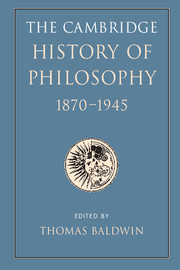Book contents
- Frontmatter
- Contents
- List of contributors
- Introduction
- I 1870–1914
- II 1914–1945
- 8 Logic and philosophy: the analytic programme
- 9 The diversity of philosophy
- 10 Knowledge, language, and the end of metaphysics
- 11 Philosophy and the exact sciences
- 46 First-order logic and its rivals
- 47 The golden age of mathematical logic
- 48 General relativity
- 49 Scientific explanation
- 50 The rise of probabilistic thinking
- 12 Mind and its place in nature
- 13 Philosophy and social science
- 14 Ethics, religion, and the arts
- 15 Law and politics
- Biobibliographical appendix
- Bibliography
- INDEX
- References
48 - General relativity
from 11 - Philosophy and the exact sciences
Published online by Cambridge University Press: 28 March 2008
- Frontmatter
- Contents
- List of contributors
- Introduction
- I 1870–1914
- II 1914–1945
- 8 Logic and philosophy: the analytic programme
- 9 The diversity of philosophy
- 10 Knowledge, language, and the end of metaphysics
- 11 Philosophy and the exact sciences
- 46 First-order logic and its rivals
- 47 The golden age of mathematical logic
- 48 General relativity
- 49 Scientific explanation
- 50 The rise of probabilistic thinking
- 12 Mind and its place in nature
- 13 Philosophy and social science
- 14 Ethics, religion, and the arts
- 15 Law and politics
- Biobibliographical appendix
- Bibliography
- INDEX
- References
Summary
The initial empirical corroboration of the General Theory of Relativity (GTR) was announced to the world at a packed joint meeting of the Royal Society of London and the Royal Astronomical Society on 6 November 1919. Lengthy data analysis of solar eclipse observations, made the previous May by a joint British expedition to Brazil and to an island off the coast of West Africa, confirmed that the GTR-predicted amount of ‘bending’ of light rays in the solar gravitational field had indeed been found. Under a portrait of Isaac Newton, J. J. Thompson, president of the Royal Society, pronounced this ‘the most important result obtained in connection with the theory of gravitation since Newton’s day, and … one of the highest achievements of human thought’ (quoted from Pais 1982: 305). There followed the ‘relativity-rumpus’ (Sommerfeld 1949: 101), a public clamour that, regarding a purely scientific theory without apparent military or technological application, was completely unprecedented, and is, as yet, unmatched. Almost overnight, Albert Einstein, hitherto largely unknown outside the rarefied (and by present standards, miniscule) circle of theoretical physicists, became world famous and a favoured target of anti-Semitism.
A plausible explanation of this astonishing spectacle points to the exhausted state of European culture, eager for diversion after the ravages of four years of world war, political revolution, and an influenza pandemic in which millions perished. Diversion the theory certainly provided, with the novelty of claims made on its behalf and its aura of incomprehensibility. But even among the scientifically literate, there was considerable controversy and misunderstanding concerning the theory’s physical content as well as its philosophical implications.
- Type
- Chapter
- Information
- The Cambridge History of Philosophy 1870–1945 , pp. 600 - 607Publisher: Cambridge University PressPrint publication year: 2003



